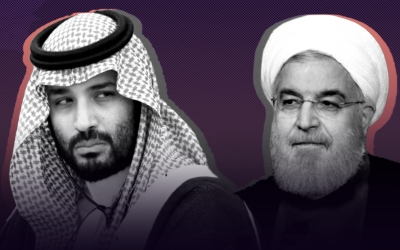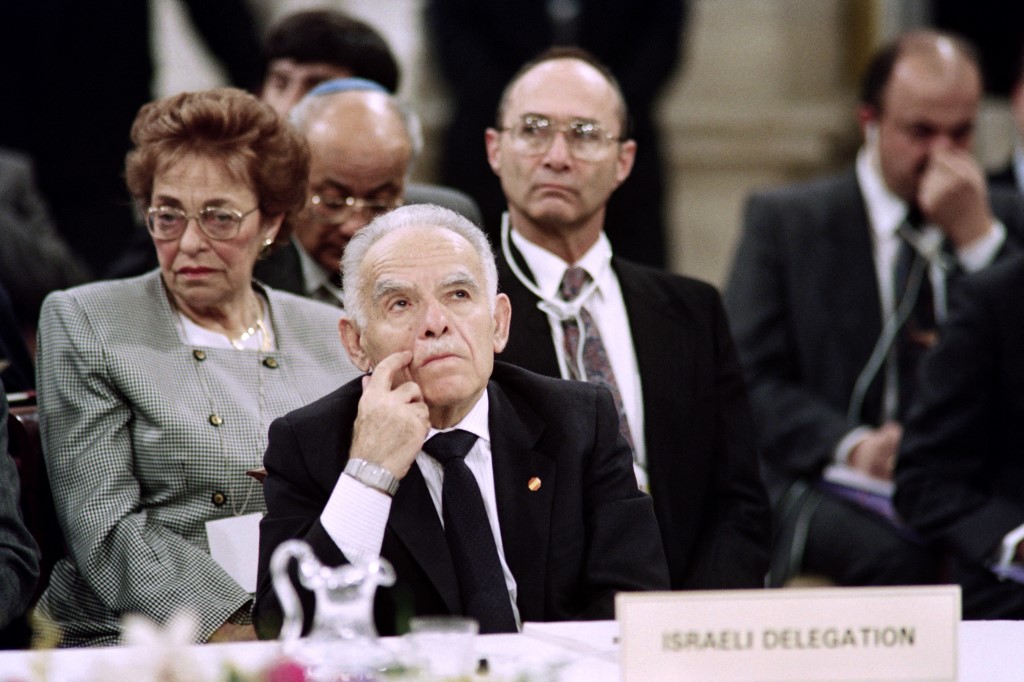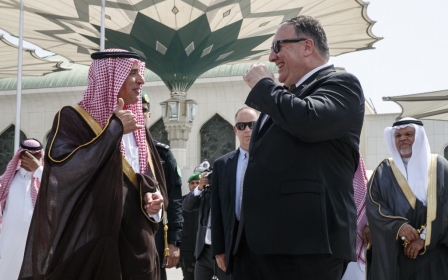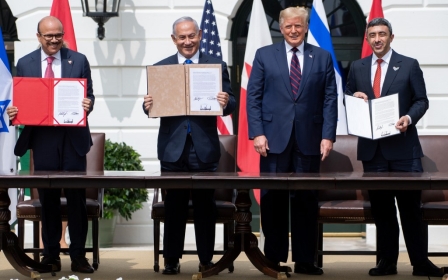How the Iran 'threat' led to Arab-Israeli alliance

A major anti-Palestinian campaign in Gulf media and social networks was launched last week, sparked by Palestinian demonstrators’ condemnation of the ongoing Saudi-UAE war against Yemen. Protesters were accused of supporting Iran against the Saudis, rather than standing by the Yemeni victims. Hamas cowered in fear and condemned the anti-Saudi slogans.
More than four decades ago, the triumph of the Iranian revolution sent shockwaves across the Arabian Peninsula. The dictatorial ruling families of the Arab monarchies, who had been subordinate allies of the Shah for decades, felt rightly threatened by the popular will of the Iranian people.
The problem they faced was not an Iranian revolutionary military threat, but a battle for legitimacy in the hearts and minds of the Arab peoples
Having weathered their own labour movements and revolutionary struggles from the 1950s through the mid-1970s, and with the defeat of the Dhofar Rebellion in Oman in 1976 and the containment of South Yemen, they had hoped they could finally sit back and relax. But it was not to be: Gulf states sponsored Iraq’s invasion of Iran to end the revolution, but instead, they bankrupted Iraq and sacrificed more than a million lives to preserve their thrones.
Yet, the problem they faced was not an Iranian revolutionary military threat, but a battle for legitimacy in the hearts and minds of the Arab peoples. The ruling Arab oil families had a dual task: to try to defeat Iran militarily, and to ensure that the revolution would not become an inspiration for Arabs living under dictatorial regimes rivalling the dictatorship of the Shah. In so doing, they sought to declare Iran and its revolution the existential enemy of all Arabs.
The problem was that the Arabs already had an existential enemy in the settler-colonial state of Israel. The US had tried since the 1950s to force the Arab peoples to consider the Soviet Union as their primary enemy, but failed miserably. Saudi Arabia, the leader of the pack, had its work cut out for it.
Long and tortuous road
Concomitant with Iraq’s military invasion, the Saudis began their political efforts to replace Israel with Iran as the principal enemy of all Arabs. This entailed coming out in support of Israel as a friend of the Arabs, and hopefully their ally against the Iranian enemy - especially as Israel, like the Gulf dictatorships, had been a close ally of the Shah, which predictably earned it the undying enmity of the Iranian revolutionary regime.
The road ahead was long and tortuous, but the Saudis had little choice. Enter Crown Prince Fahd’s peace plan of 1981, which promised Arab recognition of the Jewish settler-colony, provided it withdrew from the territories it occupied in 1967 and allowed the establishment of a Palestinian state. This, it was hoped, would end Israel’s status as the primary enemy of the Arabs.
The Americans cautiously praised the plan, and then-Palestinian leader Yasser Arafat welcomed it, but then-Egyptian President Anwar Sadat rejected it, as it did not take into account the 1978 Camp David Accords. The Israelis also rejected the plan, while welcoming its recognition of Israel.
But Fahd’s plan was undercut by the Israeli invasion and occupation of Lebanon in 1982, which led to the defeat of the Palestine Liberation Organization (PLO) and its expulsion from Lebanon. Later that year, days before the Arab League convened in Morocco to adopt the Fahd plan, then-US President Ronald Reagan issued his own “peace plan” that rejected Palestinian statehood. Israel rejected it immediately.
Arafat, who had been flirting with the US since the mid-1970s to solicit its recognition of the PLO, came to Amman in October 1982 for talks on setting up a Jordanian-Palestinian confederation that would see King Hussein of Jordan negotiate with the Americans at the behest of the Palestinians.
Arafat was also subcontracted to bring Egypt, which had been expelled by the Arab League for surrendering to Israel in a “separate peace" at Camp David, back into the Arab fold, so that all Arabs and Israel could unite against the new Iranian enemy. En route from Lebanon to his new exile in Tunisia in December 1983, Arafat made a stopover in Egypt and literally embraced then-president Hosni Mubarak.
Israeli intransigence
These efforts, however, were frustrated by Israeli colonial intransigence, challenges to Arafat’s compromise within the PLO, King Hussein’s unwavering commitment to the Reagan scheme, the Palestinian Intifada of 1987-1993, and the military defeat of Iraq by Iran in 1988. No amount of anti-Iran propaganda could dislodge Israel from its rightful place as the principal enemy of all Arabs.
Bankrupted by the war he had launched with the backing of the Gulf regimes who abandoned him after his defeat, Saddam Hussein invaded Kuwait in August 1990. This brought the military might of US imperialism and its Arab allies down on him, and was used by the US and the Saudis as an opportunity to try again to normalise Israel in the region. In the wake of the liberation of Kuwait in 1991, the US co-sponsored the Madrid Peace Conference, and the Palestinians were only allowed to attend as part of the Jordanian delegation.
Madrid would soon lead to Oslo and the transformation of the PLO from a liberation movement into a collaborator with the Israeli occupation, subcontracted by the Israelis to put down Palestinian resistance. In 2000, the Lebanese resistance, led by Hezbollah, forced the Israelis to withdraw unconditionally from south Lebanon, an unprecedented triumph. That Hezbollah was a Shia group backed by Iran raised more alarms for the Americans and Arab Gulf regimes.
This development was compounded by the US invasion and occupation of Iraq in 2003, which, to the chagrin of the Americans and the Saudis, led to the emergence of pro-Iranian Iraqi currents in the country and an Iraq-Iran rapprochement. A new sectarian campaign was now engineered to target not only Iran, but all Shia as the enemy of the Arab peoples.
King Abdullah II of Jordan voiced his concern in 2004 about the formation of what he called a Shia “crescent”, extending from Iran to Iraq, Syria and Lebanon. When the Israelis attacked Lebanon in 2006 and were soundly defeated by Hezbollah, the Saudis became apoplectic. The Iranian threat had increased by leaps and bounds, yet Israel, not Iran, remained the principal enemy of the Arabs. All the Saudi efforts to normalise it by sacrificing Palestinian rights for decades appeared to have failed.
Sectarian messaging
The sectarian campaign intensified further after Israel’s 2006 defeat in Lebanon, reaching a crescendo with the repression of the Syrian revolt of 2011 and the sectarian war that ensued, with Saudi and Gulf support. Success was at hand: the Gulf regimes effectively came to control the vast majority of Arab print and televised media, which transmitted their sectarian anti-Shia/anti-Iran and pro-Israel message far and wide.
This culminated in the increasing clandestine relations with Israel, which came out into the open in 2019. The conditions set by the Fahd plan for Arab recognition of Israel, namely its withdrawal from the territories it occupied in 1967 and the establishment of a Palestinian state, were dropped, and relations could be opened without any conditions.
The Saudi plan to make Israel a friend and Iran the enemy ultimately succeeded at the state level, but also among the new liberal and social-media-savvy intelligentsia
Under the guidance of the Trump administration and subsequently backed by the Biden administration, and with the full support of the European Union, military and political alliances with Israel were announced by the UAE, Bahrain, and more recently Morocco and Sudan. Former Israeli Prime Minister Benjamin Netanyahu said in early 2019 that Arab countries were “sitting down together with Israel in order to advance the common interest of war with Iran”.
The only remaining obstacle to making Israel the friend and ally of the Arabs was the Palestinian people.
The Saudi plan to make Israel a friend and Iran the enemy ultimately succeeded at the state level, but also among the new liberal and social-media-savvy intelligentsia in Saudi Arabia and the UAE, not to mention Jordan, Egypt, Lebanon, and the Syrian exile community.
While supporters of the Fatah-dominated Palestinian Authority and its operatives went so far as to accuse the "Sunni" Hamas in 2007 of being "Shiites", on account of the support Hamas receives from Iran and its refusal to collaborate with Israel, most Palestinians and Arabs insist that Israel - and not Iran - is their main enemy.
Last week’s demonstrators in Gaza protesting the Yemen war understood well the Saudi-Israeli anti-Palestinian alliance. The response of the anti-Iran campaigners was swift and purports to spread a direct and succinct message: namely, that only some Gaza Palestinians are the enemies of Israel and its Arab regime allies - but Iran is the enemy of all Arabs.
The views expressed in this article belong to the author and do not necessarily reflect the editorial policy of Middle East Eye.
Middle East Eye propose une couverture et une analyse indépendantes et incomparables du Moyen-Orient, de l’Afrique du Nord et d’autres régions du monde. Pour en savoir plus sur la reprise de ce contenu et les frais qui s’appliquent, veuillez remplir ce formulaire [en anglais]. Pour en savoir plus sur MEE, cliquez ici [en anglais].







